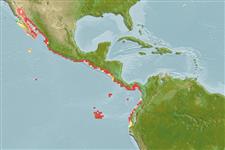>
Eupercaria/misc (Various families in series Eupercaria) >
Lutjanidae (Snappers) > Lutjaninae
Etymology: Lutjanus: Malay, ikan lutjan, name of a fish.
More on author: Günther.
Environment: milieu / climate zone / depth range / distribution range
Ecología
marino asociado a arrecife; rango de profundidad 0 - 60 m (Ref. 55763). Tropical; 33°N - 5°S, 117°W - 77°W (Ref. 55)
Eastern Pacific: Mexico to Ecuador.
Tamaño / Peso / Age
Maturity: Lm ? range ? - ? cm
Max length : 100.0 cm TL macho / no sexado; (Ref. 55763); common length : 35.0 cm TL macho / no sexado; (Ref. 55763); peso máximo publicado: 15.0 kg (Ref. 40637)
Espinas dorsales (total): 11 - 12; Radios blandos dorsales (total): 12; Espinas anales 3; Radios blandos anales: 7 - 8. Preopercular notch and knob moderate. Scale rows on back parallel to lateral line. Dark gray-green on back, lighter on belly. Scales with yellowish white centers, forming alternating dark and light stripes on the sides. Individuals from deeper waters are mainly reddish.
This is an inshore, reef-dwelling species found over hard bottoms until at least 50 m depth (Ref. 9313). Adults may form schools consisting of several hundreds of individuals (Ref. 9313). Juveniles are encountered in shallow waters, including littoral pools and estuaries (Ref. 9313). Carnivorous, feed on fish and invertebrates (Ref. 9313). Marketed fresh.
Life cycle and mating behavior
Madurez | Reproducción | Puesta | Huevos | Fecundidad | Larva
Allen, G.R., 1985. FAO Species Catalogue. Vol. 6. Snappers of the world. An annotated and illustrated catalogue of lutjanid species known to date. FAO Fish. Synop. 125(6):208 p. Rome: FAO. (Ref. 55)
IUCN Red List Status (Ref. 130435)
Threat to humans
Harmless
Human uses
Pesquerías: pesquerías de subsistencia
Más información
Nombres comunesSinónimosMetabolismoDespredadoresEcotoxicologíaReproducciónMadurezPuestaAgregación para la puestaFecundidadHuevosEgg development
ReferenciasAcuiculturaPerfil de acuiculturaRazasGenéticaElectrophoresesheritabilidadEnfermedadesProcesamientoNutrientsMass conversion
ColaboradoresImágenesStamps, Coins Misc.SonidosCiguateraVelocidadTipo de nataciónSuperficie branquialOtolitosCerebrosVisión
Herramientas
Special reports
Download XML
Fuentes de Internet
Estimates based on models
Preferred temperature (Ref.
123201): 20.6 - 28.7, mean 25.9 °C (based on 76 cells).
Phylogenetic diversity index (Ref.
82804): PD
50 = 0.5000 [Uniqueness, from 0.5 = low to 2.0 = high].
Bayesian length-weight: a=0.01479 (0.00706 - 0.03101), b=2.97 (2.81 - 3.13), in cm total length, based on LWR estimates for this Genus-body shape (Ref.
93245).
Nivel trófico (Ref.
69278): 4.1 ±0.65 se; based on food items.
Resiliencia (Ref.
120179): Bajo, población duplicada en un tiempo mínimo de 4.5-14 años (Preliminary K or Fecundity.).
Fishing Vulnerability (Ref.
59153): High vulnerability (60 of 100).
Nutrients (Ref.
124155): Calcium = 20.7 [13.2, 30.8] mg/100g; Iron = 0.272 [0.173, 0.414] mg/100g; Protein = 18.7 [17.2, 20.0] %; Omega3 = 0.117 [0.082, 0.161] g/100g; Selenium = 71 [47, 106] μg/100g; VitaminA = 106 [20, 381] μg/100g; Zinc = 0.364 [0.295, 0.495] mg/100g (wet weight);
